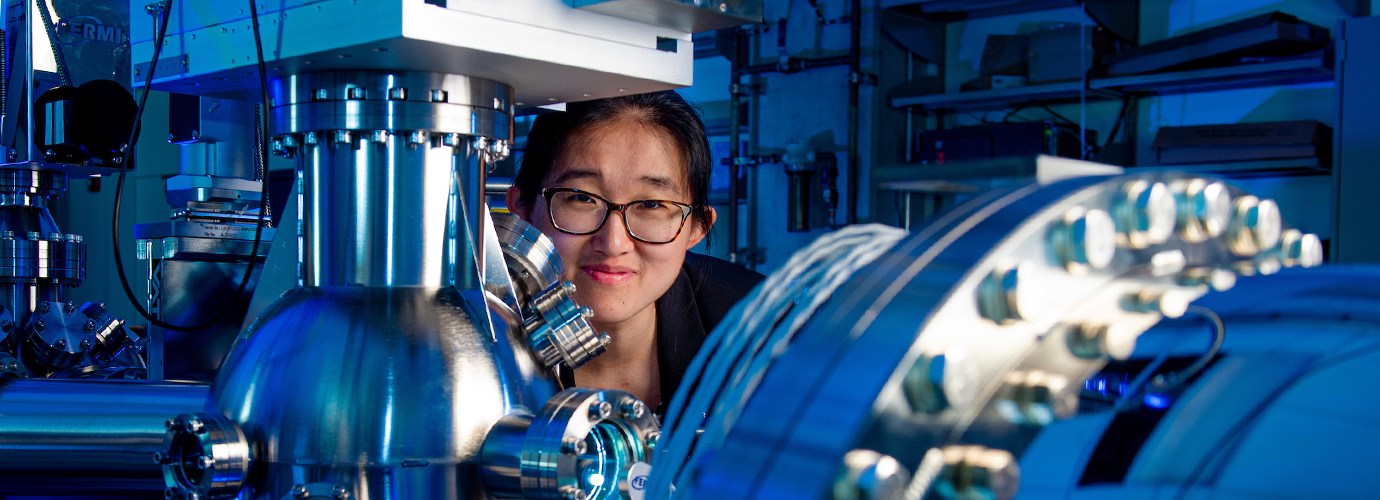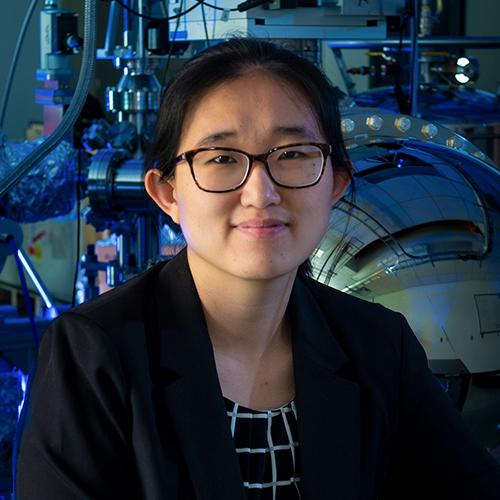
As an assistant professor of physics and astronomy, Ming Yi spends her days with special microscopes scrutinizing and studying electrons, with the ultimate goal of contributing to new technologies that can improve our everyday lives.
Yi, whose cutting-edge research lab is housed in Brockman Hall, studies exotic quantum materials such as high temperature superconductors and topological matter whose properties are not yet well understood. “Our goal is to use different types of experimental techniques to probe the electrons living in these materials to see why they behave the way they like to behave in these microscopic quantum worlds,” she says. “It’s like solving a big puzzle.”
Her research is critical to quantum materials science, a key field as it becomes increasingly clear that renewable energy must play a major role in global energy supply both now and in the coming years.
Yi was born in China and came to the U.S. at age 12. Her father works in atmospheric sciences, and from an early age Yi absorbed his lessons on why clouds exist or why it’s hot on a given day. “He told me stories about scientists,” she says. In high school she took to physics, especially, for its well-defined overarching framework.
At MIT, she continued to pursue physics, then earned her PhD in physics from Stanford. Her thesis looked at electronic phases in iron-based high temperature superconductors. Yi joined Rice in 2018 as an experimental condensed matter physicist.
In the lab, Yi uses and advances experimental tools such as angle-resolved photoemission spectroscopy (ARPES) in her work. Her passion is studying materials such as high-temperature superconductors, or compounds that behave as superconductors due to very strong interaction amongst the electrons as they zoom around in the material. Learning more about these materials and their electrons’ fascinating behaviors could make it possible to create new exotic phenomena, she says.
“We’re trying to predict, make and understand exotic quantum materials that have properties that never have been seen before and determine which ones can contribute to the future,” she says. For example, discoveries made in her lab could eventually contribute to advancing quantum computing with faster computers.
With new technologies applied to them, superconductors could also one day, for example, be used to make power grids more efficient, transmitting energy without waste. Another application could be more energy efficient magnetic levitation (MAGLEV) trains. These trains that use properties of superconductors to float over tracks already exist and can travel at much higher speeds than traditional trains. Yet current materials must be cooled down to properly operate. Yi’s research could help contribute to solutions to finding materials that work at room temperature.
In her most recent work, Yi is studying kagome metals, a material whose atoms are arranged to resemble a Japanese basket weaving pattern called a Kagome weave. “It’s become a very active field over the last few years,” she says. “We’re trying to see if we can understand and then predict how the special pattern of the atomic lattice pampers or facilitates the electrons to do choregraphed dances on the lattice that can cause a large-scale makeover of the material properties.” That kind of understanding, she says, could take scientists one step closer to realizing materials by design, or a “bottom-up” approach to designing and creating structures, atom by atom to achieve desired properties such as super strength or superconductivity.
“It’s like those heroes in the Marvel movies that conjure up whatever weapons they need at the moment to prevent the universe from falling apart,” she says.
Rice has been a welcoming environment in which to carry out her studies. “I really enjoy the research environment at Rice,” Yi says. “What’s really strong about Rice is the groups that work on these types of quantum materials challenges are all very strong and complementary. We each look for and find different pieces of this puzzle using our specialties, and we often work together to solve these puzzles. Like emergent phases in condensed matter physics, exotic findings really rely on a very strong collective and collaborative research environment.”
If you are interested in helping scientists and innovators pursue pathbreaking research like Ming’s, contact your development officer or Jackie Macha, director of development for Natural Sciences, at 713-348-4268 or jackie.macha@rice.edu.




